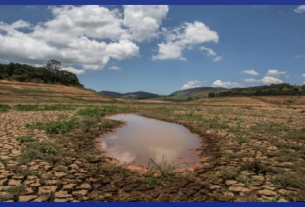The cover image for our June issue shows a ‘deeper look’ into species-rich mountain grassland in the Krkonoše Mountains, Czech Republic. This image relates to the article ‘Plant–soil feedbacks in a diverse grassland: Soil remembers, but not too much‘, by Eliška Kuťáková et al. Here, Eliška tells us the story behind the image:
Being a plant ecologist, one often finds moments of idyllic serenity while traversing blossoming meadows (if only I had a nickel for every time someone told me ‘You study plants? That is so lovely!‘…). Yes, our fieldwork often involves beautiful scenery, and can be a truly enjoyable experience. However, it simultaneously presents physical and mental challenges, and undoubtedly, it involves immersing oneself in a gritty and soiled expedition. One of the essential tasks every belowground-focused ecologist knows very well – the result of which is captured in the cover photograph – is soil sampling.

My first soil sampling experience caught me absolutely off guard. I was a bachelor student collecting vegetation data in an abandoned limestone quarry. When I was asked if I could help with soil sampling too, of course I said yes. However, hours later, I found myself experiencing all the immense microclimatic challenges the plants endured at that site: clay substrate as hard as concrete, wedged among various-sized rocks, and scorching air temperatures. The sampling proved to be arduous. The presence of the rocks made it practically impossible to use the shovel. And, because of all the rocks, we needed to dig out really large samples to obtain enough fine earth for the analyses. I have to admit that after carrying the tens of kilograms of soil in my backpack to the car, I was really questioning my choice of study field.
But now, quite some years later and still in ecology, I really enjoy soil sampling. Besides the fact that I learned to appreciate any physical exercise after hours in front of a computer screen, I realized this hands-on task provides an amazing opportunity for observing. As an example, soil sampling for one of our experiments exploring plant-soil interactions in the Krkonoše Mountains was quite revealing. We needed to separate two distinct soil layers, each characterized by varying representation of individual species’ roots. To do that, we used a custom-made sampling plate and dug out the whole soil monolith that we subsequently split into the two layers. After we took each monolith out, we could clearly see the decreasing amount of roots with increasing depth. Moreover, the complexity of the belowground world was just striking, with roots of individual species highly intermingled, implying sophisticated interactions. Indeed, a first preview of what we found later in our experiments.
Studying soils is the art of observing part of the ecosystem that is hidden to us, but where most species’ interactions occur. Looking at a soil profile when digging gives us the context of its structure, moisture, distribution of roots, presence of soil fauna – and much more. And it is exactly this context that is often essential for interpretation of our ‘aboveground’ results and for new ideas to be born. Engaging in soil digging is simply great!




